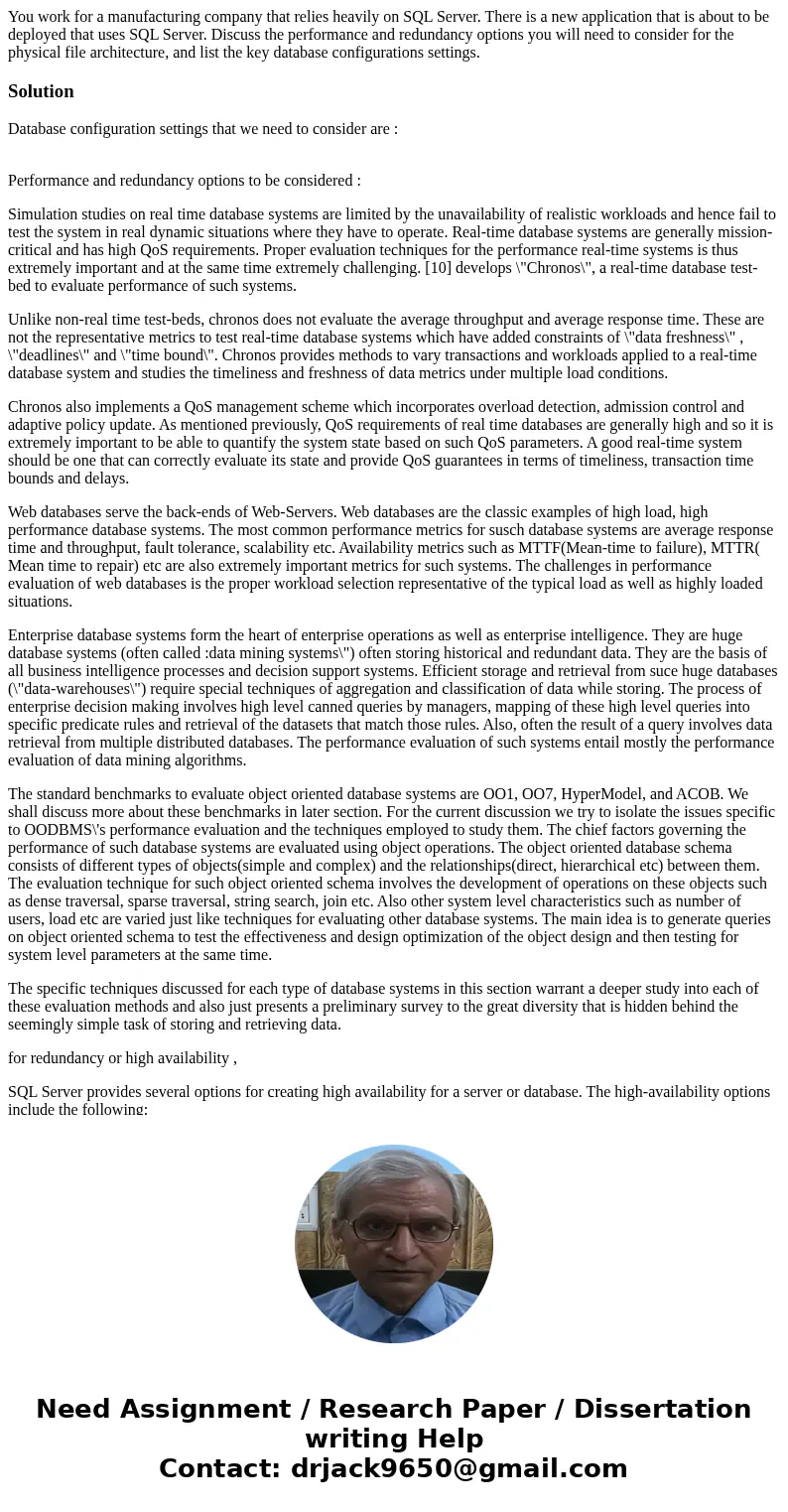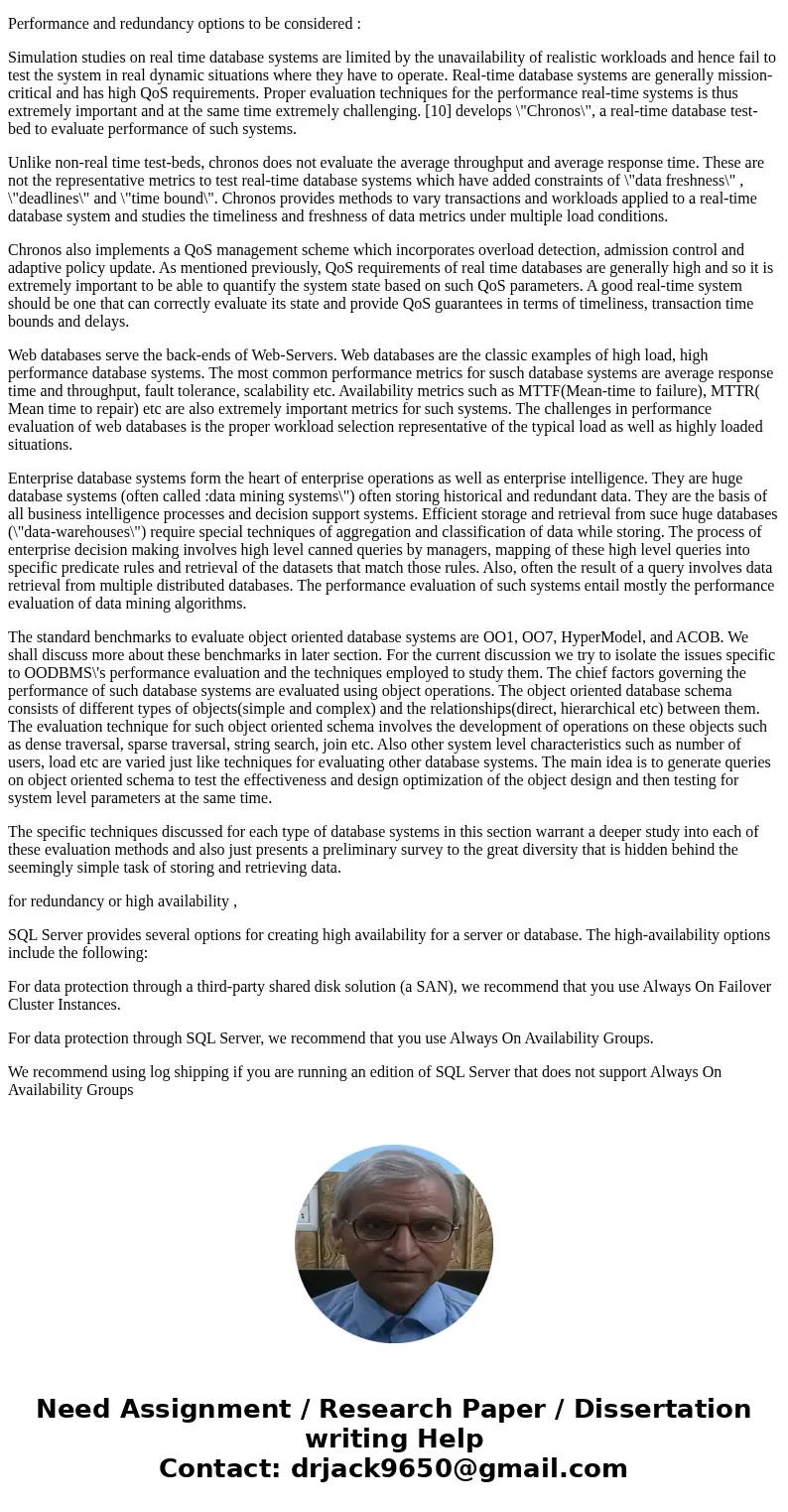You work for a manufacturing company that relies heavily on
You work for a manufacturing company that relies heavily on SQL Server. There is a new application that is about to be deployed that uses SQL Server. Discuss the performance and redundancy options you will need to consider for the physical file architecture, and list the key database configurations settings.
Solution
Database configuration settings that we need to consider are :
Performance and redundancy options to be considered :
Simulation studies on real time database systems are limited by the unavailability of realistic workloads and hence fail to test the system in real dynamic situations where they have to operate. Real-time database systems are generally mission-critical and has high QoS requirements. Proper evaluation techniques for the performance real-time systems is thus extremely important and at the same time extremely challenging. [10] develops \"Chronos\", a real-time database test-bed to evaluate performance of such systems.
Unlike non-real time test-beds, chronos does not evaluate the average throughput and average response time. These are not the representative metrics to test real-time database systems which have added constraints of \"data freshness\" , \"deadlines\" and \"time bound\". Chronos provides methods to vary transactions and workloads applied to a real-time database system and studies the timeliness and freshness of data metrics under multiple load conditions.
Chronos also implements a QoS management scheme which incorporates overload detection, admission control and adaptive policy update. As mentioned previously, QoS requirements of real time databases are generally high and so it is extremely important to be able to quantify the system state based on such QoS parameters. A good real-time system should be one that can correctly evaluate its state and provide QoS guarantees in terms of timeliness, transaction time bounds and delays.
Web databases serve the back-ends of Web-Servers. Web databases are the classic examples of high load, high performance database systems. The most common performance metrics for susch database systems are average response time and throughput, fault tolerance, scalability etc. Availability metrics such as MTTF(Mean-time to failure), MTTR( Mean time to repair) etc are also extremely important metrics for such systems. The challenges in performance evaluation of web databases is the proper workload selection representative of the typical load as well as highly loaded situations.
Enterprise database systems form the heart of enterprise operations as well as enterprise intelligence. They are huge database systems (often called :data mining systems\") often storing historical and redundant data. They are the basis of all business intelligence processes and decision support systems. Efficient storage and retrieval from suce huge databases (\"data-warehouses\") require special techniques of aggregation and classification of data while storing. The process of enterprise decision making involves high level canned queries by managers, mapping of these high level queries into specific predicate rules and retrieval of the datasets that match those rules. Also, often the result of a query involves data retrieval from multiple distributed databases. The performance evaluation of such systems entail mostly the performance evaluation of data mining algorithms.
The standard benchmarks to evaluate object oriented database systems are OO1, OO7, HyperModel, and ACOB. We shall discuss more about these benchmarks in later section. For the current discussion we try to isolate the issues specific to OODBMS\'s performance evaluation and the techniques employed to study them. The chief factors governing the performance of such database systems are evaluated using object operations. The object oriented database schema consists of different types of objects(simple and complex) and the relationships(direct, hierarchical etc) between them. The evaluation technique for such object oriented schema involves the development of operations on these objects such as dense traversal, sparse traversal, string search, join etc. Also other system level characteristics such as number of users, load etc are varied just like techniques for evaluating other database systems. The main idea is to generate queries on object oriented schema to test the effectiveness and design optimization of the object design and then testing for system level parameters at the same time.
The specific techniques discussed for each type of database systems in this section warrant a deeper study into each of these evaluation methods and also just presents a preliminary survey to the great diversity that is hidden behind the seemingly simple task of storing and retrieving data.
for redundancy or high availability ,
SQL Server provides several options for creating high availability for a server or database. The high-availability options include the following:
For data protection through a third-party shared disk solution (a SAN), we recommend that you use Always On Failover Cluster Instances.
For data protection through SQL Server, we recommend that you use Always On Availability Groups.
We recommend using log shipping if you are running an edition of SQL Server that does not support Always On Availability Groups


 Homework Sourse
Homework Sourse